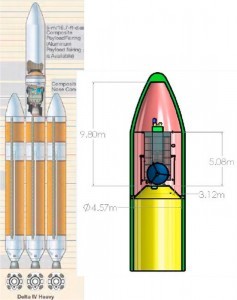The odds of the Earth being hit by a large asteroid are extremely slim, but the potential damage is extremely large, so a partnership of scientists have been studying a conceptual spacecraft designed to deflect dangerous asteroids before they reach us. Called the Hypervelocity Asteroid Mitigation Mission for Emergency Response (HAMMER) vehicle, the 9-m (30-ft) tall, 8.8-ton spacecraft is a modular construct that can either ram an asteroid directly or act as a bomb carrier to deliver a nuclear warhead.
According to NASA, no one has been killed by an asteroid or meteorite in over a thousand years, but there have been many close calls. In addition, exploration of the Solar System, Earth’s geological history and even recent historical events like the Tunguska Event show that an asteroid strike could have catastrophic effects, possibly even the kind of mass extinctions not seen since the dinosaurs died out 65 million years ago.
With this in mind, a collaborative study by NASA, the National Nuclear Security Administration (NNSA), the Lawrence Livermore National Laboratory (LLNL) and Los Alamos National Laboratory is looking into how an unmanned spacecraft could handle an Earth-threatening asteroid. For theoretical purposes, the scientists chose the asteroid 101955 Bennu, which is an asteroid that passes the Earth’s orbit on a regular basis and is calculated to have a 2,700 to one chance of hitting the Earth on September 25, 2135.
In addition to this, Bennu is massive with a 500-m (1,600-ft) diameter, that’s greater than the height of the Empire State Building, and a weight of 79 billion kg (175 billion lb). LLNL says that if it struck the Earth, it would be the equivalent of a 1,200 megaton bomb – 80,000 times more powerful than the atomic bomb used on Hiroshima in 1945.
The purpose of the study is to balance the requirements of intercepting and deflecting an asteroid while it is still far from Earth against that needed when it’s very close. The study took three different approaches with NASA handling the former, while LLNL dealt with the latter plus emergency response if the first two fail. Also, they looked at two possible deflecting strategies – a kinetic impact using the HAMMER probe’s inertia to shift the asteroid, and using a nuclear warhead.
According to LLNL, the preferred method is to hit the asteroid with a kinetic impactor while it’s still far away. And the farther the better. This is because even a minuscule change of trajectory while the asteroid is hundreds of millions of miles away will add up to a miss of many millions of miles when it reaches the Earth, but the closer it is, the greater the deflection needed and the smaller the result.
“The push you need to give it is very small if you deflect the asteroid 50 years out,” says Kirsten Howley, LLNL physicist. “But that far out, you’re likely to think the percentage of being hit would be one percent. The probability of a Bennu impact may be one in 2,700 today, but that will almost certainly change – for better or worse – as we gather more data about its orbit. Delay is the greatest enemy of any asteroid deflection mission. That’s why there’s urgency in getting viable deflection platforms on the shelf today.”
The study also had to take into account how long it would require to develop the spacecraft and launch a mission to deflect Bennu, which would be a minimum of 7.4 years. Looking at a series of scenarios launching from 10 to 25 years before impact, the scientists found that the 10-year scenario would require 34 to 53 launches by Delta IV Heavy rockets, each carrying one HAMMER impactor, where the 25-year mission needed only seven to 11.
“When many launches are required for a successful deflection, the mission success becomes more difficult, due to the failure rate associated with each individual launch,” says Megan Bruck Syal, LLNL physicist. “If we only had 10 years from launch, we would need to hit Bennu with hundreds of tons of HAMMER mass just to barely deflect it off of an Earth-impacting path, requiring dozens of successful launches and impact at the asteroid.”
The present study concluded that an impactor fleet could deflect Bennu, but the team is also looking at using nuclear weapons as an alternative – especially in cases of larger objects. These wouldn’t blow up the asteroid or even hit it. Instead, the warhead would be detonated at a distance, causing a layer of asteroid to vaporize. This would generate a rocket-like thrust as the vaporized material is ejected from the surface. By selecting the proper angle and distance, it should be possible to control how much energy will be delivered to the asteroid, and better determine in which direction it will go.
Unfortunately, both approaches may be a bit trickier in real life. While Bennu passes the Earth regularly and has been closely surveyed with telescopes and radar, others may not be so well studied and the deflections would be less certain. Some missions might even need to be launched a year before impact, meaning that the only option will be to hit it with a nuclear weapon in hopes of breaking it up and mitigate the impact.
“Successful disruption requires ensuring that the asteroid pieces are sufficiently small and well-dispersed, so that they pose a much-reduced threat to the Earth,” says Syal. “Disruption carried out as late as tens of days before impact can still be very effective in reducing the total damage felt by Earth. Previous work by our research group has shown that the impacting debris is reduced to less than one percent of its initial mass by disrupting the asteroid, even at these late times.”
Source: newatlas
Ask me anything
Explore related questions









